
TREATMENT HELPS DELAY ONSET OF GLAUCOMA
Drops of Prevention
![]()
phthalmologists at the School of Medicine’s Bascom Palmer Eye Institute
have their sights set on a preventive treatment strategy for patients
at high risk for glaucoma. Bascom Palmer researchers are among those who
recently discovered that eye drops used to treat elevated pressure help
delay onset of the disease.
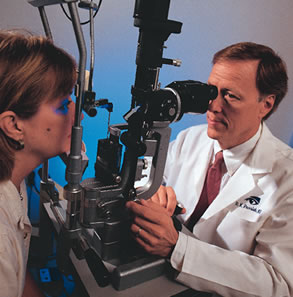 |
||
Investigators from 22 sites around the country, including the team at Bascom Palmer, collaborated on the Ocular Hypertension Treatment Study, involving more than 1,500 subjects 40 to 80 years of age who had elevated eye pressure but no signs of glaucoma. Elevated eye pressure results when the fluid that flows in and out of the eye drains too slowly, a condition that affects an estimated three to six million people in the United States, including four to seven percent of those over age 40. This increased pressure can damage the optic nerve, leading to the development of glaucoma.
Study participants were assigned either daily doses of eye drops that reduced pressure by approximately 20 percent or observation without medication. Treatment with the drops was found to reduce the development of primary open-angle glaucoma by more than 50 percent: 4.4 percent of participants who received the drops developed glaucoma within five years, compared with 9.5 percent who did not receive medication.
Investigators also identified significant risk factors associated with the development of glaucoma, including older age, African descent, high eye pressure, thinness of the cornea, and the anatomy of the optic nerve. As each patient presents a different mix of symptoms and risk factors, preventive treatment with eye drops may not be suitable across the board, the study’s leaders cautioned.
“For the first time we have firm evidence that treatment with eye drops to lower intraocular pressure will prevent certain patients from developing glaucoma,” says Richard K. Parrish II, M.D., professor of ophthalmology at Bascom Palmer and vice-chair for the study. “Race, appearance of the optic nerve, and corneal thickness are important factors to consider when judging the risk for an individual patient and deciding whether to begin treatment.”
|
Nine Specialties Rated Best for Patient Care |
|
“Nothing is more important to us than the quality of patient care we provide as South Florida’s only academic medical center,” says John G. Clarkson, M.D. ’68, senior vice president for medical affairs and dean of the School of Medicine. In addition to Bascom Palmer’s stellar performance, the School of Medicine’s other ranked specialties include kidney disease (24th); orthopaedics (24th); gynecology (27th); hormonal disorders (33rd); ear, nose, and throat (36th); geriatrics (38th); digestive disorders (39th); and heart and heart surgery (50th). This year’s U.S. News survey recognized 205 hospitals overall—pared down from 6,045—in 17 specialties. Each hospital received a score that equally weighed reputation (determined by a random sample of 180 board-certified physicians), mortality, and a group of care-related factors such as technology and nurse-to-patient ratios. Ophthalmology is one of four specialties that are ranked solely on peer review. |
RARE TRANSPLANT Piggybacks Donor Organ
Two of Hearts
![]()
ransplant surgeons at the University of Miami/
Jackson Memorial Medical Center gave Castelio Campos a new heart last
July—without removing his original, diseased heart.
 A
65-year-old congestive heart failure patient, Campos also suffered from
life-threatening pulmonary hypertension. He now has two hearts circulating
blood throughout his body.
A
65-year-old congestive heart failure patient, Campos also suffered from
life-threatening pulmonary hypertension. He now has two hearts circulating
blood throughout his body.
“This complex transplant is performed only when the standard operation might not work,” says Si Pham, M.D., director of the heart/lung transplant program at UM/Jackson and professor of surgery at the School of Medicine. “Only about 100 of these cardiac transplant procedures have been done in the United States since 1970.”
Called heterotopic heart transplantation, the procedure is performed when a patient has irreversible pulmonary hypertension from heart failure or when the donor heart is from a much smaller person than the recipient. In such cases, the donor heart alone may not be strong enough to correct the problem.
In Campos’ ten-hour procedure, the two hearts were placed together in a piggyback fashion. Now they work in tandem. His original right ventricle pumps most of the deoxygenated blood through the pulmonary arteries to the lungs, while the left ventricle of the donor heart pumps the oxygenated blood through the aorta to the rest of the body.
“The patient’s pulmonary hypertension has improved, and he is doing well,” says Pham.
“I am grateful for this gift because it saved my life,” says Campos, a former political prisoner in Cuba before coming to the United States in 1990. “I’d rather be in jail ten times than lie in bed expecting to die every day waiting for a donor heart.” He had been on the transplant waiting list since February 2001.
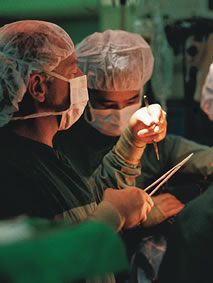 |
||
![]()
ccording to the latest statistics from the United
Network for Organ Sharing, the Division of Transplantation at the School
of Medicine is among the top echelon of programs of its kind in the nation.
Growing by more than 20 percent in 2001, the transplant program completed
the year with 464 organ transplants, making it the third most active in
the United States and the only facility in Florida in the top ten.
Surgeons at the University of Miami/Jackson Memorial Medical Center led the way for intestinal transplants, performing the most in the country with 36. The liver transplant program ranked second with 204 procedures—seven short of national leader UCLA. Kidney-pancreas and pancreas programs both were fourth.
“Our surgeons continue to dedicate themselves to providing the best and most efficient care to patients at UM/Jackson,” says Andreas Tzakis, M.D., chief of the School of Medicine’s Division of Liver and Gastro-intestinal Transplantation. “With a focus on doing as much as we can for as many patients as possible, we have been able to set the standard for medical centers across the country. Our work is made possible, however, only through the foresight and generosity of the country’s organ donors and their families.”
$5 Million GIFT CREATES BRAMAN BREAST CANCER INSTITUTE
An Urgency for New Therapies
![]()
he University of Miami Sylvester Comprehensive Cancer Center launches
a new era in breast cancer research and care with the creation of the
Braman Breast Cancer Institute, made possible by a gift from the Braman
Family Foundation.
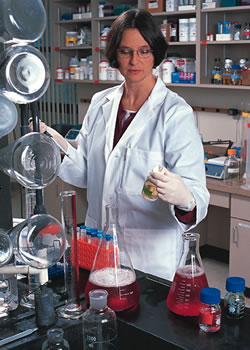 |
||
The vision of the new institute combines basic science, clinical trials, and world-class care to discover more effective treatments for breast cancer patients, with the ultimate goal to cure the disease.
“We will create a multilayered, state-of-the-art institute to deliver the best possible breast cancer care to Miami and the region,” says Joseph Rosenblatt, M.D., scientific director of UM/Sylvester. “Cutting-edge research will advance international knowledge of the causes of breast cancer and develop new means of prevention, diagnosis, and treatment.”
Researchers will explore new methods in risk assessment, early diagnosis, and predicting effective treatments. Discoveries about molecular mechanisms underlying cancer will be quickly translated from the lab to the bedside, testing new therapies in a multidisciplinary effort that exists at few centers worldwide. Recruited to lead the initiative is renowned breast cancer researcher Joyce Slingerland, M.D., Ph.D.
“Hiring Dr. Slingerland is an enormous catalyst,” says W. Jarrard Goodwin, M.D., director of UM/Sylvester. “She has impeccable scientific credentials, including widely published discoveries about the role of cell-cycle regulators in breast cancer.”
Adds John G. Clarkson, M.D. ’68, senior vice president for medical affairs and dean of the School of Medicine, “Dr. Slingerland was actively recruited by many of the premier institutions in the country, and we’re delighted that she’s chosen to lead our efforts.”
Slingerland is driven by a particular urgency to find new therapies for women with advanced stages of breast cancer.
“It is especially important for the University of Miami to have such an institute for many reasons, not the least being that the rate of breast cancer mortality in the state of Florida is among the nation’s highest,” she says. “Many of the women receiving treatment at our center develop a very aggressive form of breast cancer at a younger age. There may be new genetic markers that signal this predisposition, and this knowledge may allow us not only to devise new diagnostic tests that allow earlier breast cancer detection, but also to generate new forms of treatment.”
The Braman’s $5 million gift will enable Slingerland to recruit other physicians and research scientists to help in the development and testing of new approaches to breast cancer. The center will coordinate the efforts of experts in molecular biology, imaging, surgical care, epidemiology, genetics, radiation oncology, and medical oncology to create an innovative research and treatment environment unique in the nation.
“Norman and Irma Braman’s generous gift will lead to important innovations in cancer prevention, detection, diagnosis, and treatment,” says UM President Donna E. Shalala.
The Braman family aims to provide a patient-friendly center at UM/Sylvester where women can see all the experts they need in one place and receive appropriate counseling, if necessary.
“Breast cancer is something we all care about,” Irma Braman says. “Our hope is that someday breast cancer will be treated more effectively, so that every patient will be given increased length and quality of life.”
STUDYING HEPATITIS C IN AFRICAN-AMERICANS
A Population at Risk
![]()
niversity of Miami School of Medicine researchers
are part of a nationwide study to determine why African-Americans respond
so poorly to the standard treatment for hepatitis C. The virus, which
infects an estimated four million Americans, is much more common among
African-Americans than Caucasians. And once infected, African-Americans
are more likely to develop chronic hepatitis C.
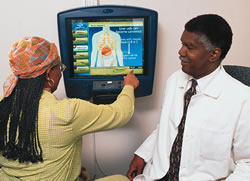 |
||
The University of Miami’s Center for Liver Diseases and the Miami Veterans Administration Medical Center are among eight clinical sites taking part in the Study of Viral Resistance to Antiviral Therapy of Chronic Hepatitis C, or VIRAHEP-C, funded by the National Institutes of Health. Across the country 400 patients—an equal number of African-Americans and Caucasians—will receive treatment for one year with the current therapy for chronic hepatitis C, a combination of pegylated, or long-acting, interferon alpha 2A plus ribavirin. They will be followed for a year after treatment to measure response.
“The treatment of African-Americans with standard interferon is not effective. The newer, long-acting versions of interferon appear to be promising, but we won’t know for sure until they are tested in a large clinical trial that includes an equal number of African-Americans,” says Lennox Jeffers, M.D., director of UM’s Center of Excellence for Hepatitis C. “There’s a lot of fear among African-Americans in taking part in clinical trials. That’s why it is vitally important to reach out to diverse populations and educate them about research, especially when it involves diseases that hit their populations so hard.”
Previous small studies have shown the poor response to interferon treatment among African-Americans, but more participants are needed for concrete results. Complicating matters, the most common type of hepatitis C found in the United States is genotype 1, the most difficult to treat. It is estimated that 90 percent of African-Americans with hepatitis C have genotype 1.
|
Celebrate the School of Medicine’s 50th Year |
|
January 31 January 31-February 1 February 2-5 |
Photography: Donna Victor, John Zillioux, Pyramid Photographics,
Jay Good (Jeffers)
Illustration: Stuart Briers
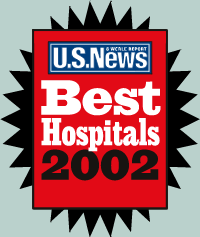 The
banner year saw UM School of Medicine programs make their biggest
mark yet with nine specialties ranked, compared with four specialties
ranked in the 2001 survey and six in 2000.
The
banner year saw UM School of Medicine programs make their biggest
mark yet with nine specialties ranked, compared with four specialties
ranked in the 2001 survey and six in 2000. Join
the School of Medicine in commemorating its 50th anniversary by
looking back at a history of excellence in discovery, knowledge,
and healing and looking ahead to the exciting possibilities for
the future. A selection of the major activities appears below. For
more information, contact the Office of Community Relations at 305-243-3453
or visit
Join
the School of Medicine in commemorating its 50th anniversary by
looking back at a history of excellence in discovery, knowledge,
and healing and looking ahead to the exciting possibilities for
the future. A selection of the major activities appears below. For
more information, contact the Office of Community Relations at 305-243-3453
or visit  Sharing
memories of the first 50 years in an afternoon of special presentations
will be members of the inaugural class, along with Deans John G.
Clarkson, M.D. ’68, Bernard J. Fogel, M.D. ’61, and Emmanuel
Papper, M.D., and former University Presidents Henry King Stanford,
Ph.D., and Edward T. Foote II, J.D. President Donna E. Shalala,
Ph.D., will join Dean Clarkson for a session on what the next 50
years hold for the school.
Sharing
memories of the first 50 years in an afternoon of special presentations
will be members of the inaugural class, along with Deans John G.
Clarkson, M.D. ’68, Bernard J. Fogel, M.D. ’61, and Emmanuel
Papper, M.D., and former University Presidents Henry King Stanford,
Ph.D., and Edward T. Foote II, J.D. President Donna E. Shalala,
Ph.D., will join Dean Clarkson for a session on what the next 50
years hold for the school.